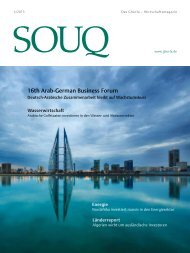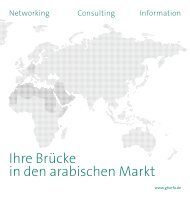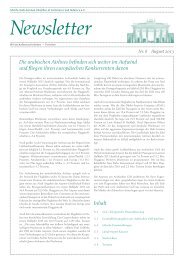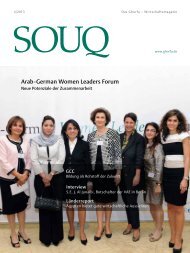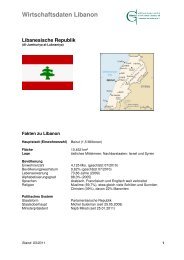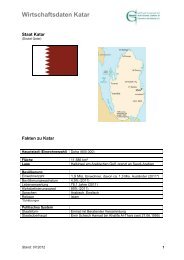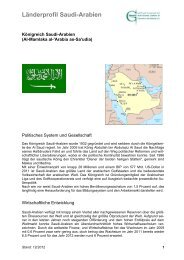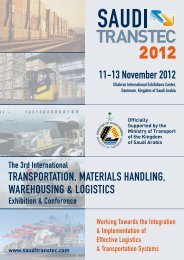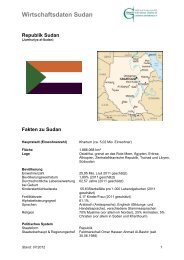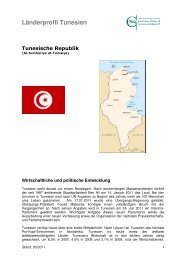Saudi-Arabien Wirtschaftshandbuch Saudi Arabia Business ... - Ghorfa
Saudi-Arabien Wirtschaftshandbuch Saudi Arabia Business ... - Ghorfa
Saudi-Arabien Wirtschaftshandbuch Saudi Arabia Business ... - Ghorfa
Sie wollen auch ein ePaper? Erhöhen Sie die Reichweite Ihrer Titel.
YUMPU macht aus Druck-PDFs automatisch weboptimierte ePaper, die Google liebt.
40<br />
entwicklung der handelsbilanz (in Mrd. uS$) 2002 2004 2005 2006 2007<br />
Export 72,3 125,7 180,1 209,2 240,2<br />
davon<br />
Öl 63,6 110,4 161,1 188,6 216,2<br />
Import 29,7 41,1 54,6 60,7 136,6<br />
Saldo 42,6 84,6 125,5 148,5 103,6<br />
Quelle: <strong>Saudi</strong> <strong>Arabia</strong>n Monetary Agency, Annual report 2007, riyadh 2007; ciA World fact Book, Washington, 2008<br />
development of the balance of trade<br />
(in billion uS$) 2002 2004 2005 2006 2007<br />
Exports 72.3 125.7 180.1 209.2 240.2<br />
of wich<br />
Oil 63.6 110.4 161.1 188.6 216.2<br />
Imports 29.7 41.1 54.6 60.7 136.6<br />
Balance 42.6 84.6 125.5 148.5 103.6<br />
Source: <strong>Saudi</strong> <strong>Arabia</strong>n monetary Agency, Annual report 2007, riyadh 2007; cIA world fact book, washington, 2008<br />
trial goods remains far behind its potential if one looks<br />
at <strong>Saudi</strong> <strong>Arabia</strong>’s strong industrial base in the MENA<br />
region.<br />
In light of the development of the oil price in recent years,<br />
the total exports from <strong>Saudi</strong> <strong>Arabia</strong> have risen significantly.<br />
The increase in exports from 72.3 billion US$ (2002)<br />
to 240.2 billion US$ (2007) has more than tripled and<br />
has risen by an annual average of 46%. The imports during<br />
this period grew by an annual average of 60% from<br />
29.7 billion US$ (2002) to 136.6 billion US$ (2007).<br />
Industrial plants, machines, transportation equipment<br />
and food goods head the import list. Due to the continuing<br />
economic boom, imports of investment goods in particular<br />
grew enormously in 2007 meaning that the total<br />
volume of the imports in this year more than doubled. According<br />
to the Central Bank, the main supplier countries<br />
were in 2006 were the USA (14.7%), Germany (8.2%),<br />
Japan (8.0%), China (8.7%), Great Britain (4.0%) and<br />
Italy (3.9%). The main customers in 2006 were the USA<br />
(share: 14.7%), China (8.7%), Germany (8.2%), Japan<br />
(8.0%), Great Britain (4.0%) and Korea (3.8%).<br />
Due to higher export levels, the balance of trade permanently<br />
shows an active trade balance despite the fast<br />
growing levels of imports since 2005. On the other hand,<br />
the service balance is passive. This is a result of the transfers<br />
of the guest workers to their home countries. Other<br />
reasons for this deficit lie in the sinking levels of incoming<br />
investment revenues and the growing insurance and<br />
shipping costs. As a result of the high surplus levels in the<br />
balance of trade, <strong>Saudi</strong> <strong>Arabia</strong> has had a trade surplus<br />
for some years; however the active balance on current account,<br />
which totalled 90.1 billion US$ in 2005 and 95.5<br />
billion US$ in 2006, has been reduced to 69.4 billion<br />
US$ in 2007 (preliminary estimate) due to the increase<br />
in imports.<br />
The positive output balance and the growing level of foreign<br />
direct investment are the decisive factors behind the<br />
fact that <strong>Saudi</strong> <strong>Arabia</strong>’s balance of payments have predominantly<br />
been in surplus since 2000 (one exception<br />
was the year 2002). The active balance of payments is an<br />
important criteria for the country’s currently stable foreign<br />
trade balance.



